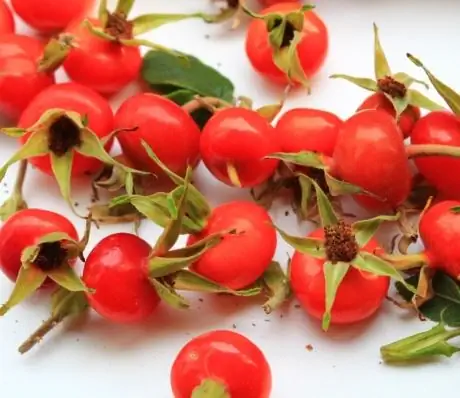- Author Rachel Wainwright [email protected].
- Public 2023-12-15 07:39.
- Last modified 2025-11-02 20:14.
Rosehip
Rosehip belongs to the pink family and the order Rosaceae. This plant has several cultivated forms, which are grown as roses or rose hips. The benefits of rose hips have been established by numerous scientific studies and the plant is considered medicinal. Rosehip is used in medicine, cosmetology, pharmacology and food industry.
The ratio of BJU in the product

Source: depositphotos.com How to burn 109 kcal?
| Walking | 27 minutes |
| Jogging | 12 minutes |
| Swimming | 9 minutes |
| A bike | 16 minutes |
| Aerobics | 22 minutes |
| Household chores | 36 minutes |
Biological features and distribution
There are over 400 species of rose hips, as well as over 100 cultivars. Rosehip shrubs have erect or creeping stems up to 10 m high. Small bushes grow in Russia, and dog rose hips up to 13 m high grow in Germany and France.
In subtropical climates, rose lilies with a tree-like shape and curved stems grow. Dwarf roses and Eichison rose hips are popular in Central Asia. They reach a height of 5-10 cm, bloom in the third year and grow up to 6 years.
Rosehip blooms in Europe in May-June for several days, and in central Russia, flowering lasts up to 20 days. The plant begins to bear fruit at the age of three and gives a bountiful harvest within 3-5 years.
The rosehip fruit is called cynarrodium and has sepals. When ripe, the fruit becomes reddish, orange or black, covered with bristles and becomes dryish. In the shape of the peduncle, cynarrodium is concave, rounded, ovoid, ellipsoid, pitcher and pear-shaped.
Rosehip began to be cultivated in many countries of the world. Various species of this plant were bred, which naturalized in the natural conditions of Europe, Asia and North America.
Useful properties of rose hips
The great benefits of rose hips are due to the rich content of vitamins and nutrients in its composition. The plant contains vitamins of group B, C and E, carotene, riboflavin, calcium, magnesium, iron, potassium, essential oils, citric acid, tannins and malic acid.
The beneficial properties of rose hips are actively used in the vitamin industry. It is used to obtain preparations with a high content of vitamin C and ascorbic acid, such as cholosas and syrup. Rosehip has anti-inflammatory, antiviral and anti-edema properties.
Revealed great benefits of rose hips in the treatment of burns, cracks, infectious diseases, bleeding gums and inflammation of the oral cavity.
Rosehip fruits contain organic acids, pectin and flavonoids, which strengthen the immune system, enhance protective functions against viral diseases, improve blood circulation and normalize blood sugar.
Rosehip is widely used in medicine and cosmetology. For medicinal purposes, plants create infusions from seeds, flowers and leaves that have a tonic and restorative effect.
Rosehip infusions and decoctions stop bleeding, promote urination and bile secretion, accelerate regeneration processes.
Rosehip is highly useful in the treatment of colds, rheumatism, tuberculosis and gastrointestinal disorders.
Calorie content of rose hips
Rosehip is the fruit of an average calorie content of 109 kcal. The plant also contains 1 g of proteins, 22 g of carbohydrates and 0.7 g of fat.
Rosehip application
In the winter period of the year, regular consumption of rose hips allows you to provide the body with the necessary amount of vitamin C and nutrients.
Fresh peeled rose hips have a sour taste and are used as a vitamin supplement together with sugar.
In folk medicine, the medicinal properties of wild rose are highly valued. The infusion is prepared from fruit shells and is used as an anesthetic. From the dried fruit, you can make a decoction and brew tea in a thermos. The infusion is recommended for people with hypertension, infectious diseases and anemia.
The flowers of the plant are brewed with honey and used as lotions to treat eye diseases. Rosehip decoction is effective in removing stones from the kidneys and bladder.
In cosmetology, rosehip oil is used, which contains fatty acids necessary for strengthening and healing the skin. Also, a special cream is made from the fruit with the addition of glycerin and ammonia, which is used to care for the skin of the hands and feet. Rosehip petals are used to create decoctions for washing and cosmetic masks that tone the skin, relieve fatigue and promote regeneration.

Contraindications
Rosehip should be consumed in moderation, as it is rich in many vitamins, nutrients and organic acids.
Broths and tinctures containing rosehip are contraindicated in liver diseases, and they should not be drunk for a long time, since there is a high probability of non-infectious jaundice.
Rosehip is contraindicated in case of individual intolerance and the presence of severe diseases of the digestive system.
Strong decoctions and rosehip infusions must be taken through a plastic tube and after using them, rinse the oral cavity to prevent yellowing of the teeth and damage to the enamel.
Contraindications to the use of rosehips are renal failure, thrombosis, hypertension and high acidity.
YouTube video related to the article:
Found a mistake in the text? Select it and press Ctrl + Enter.






